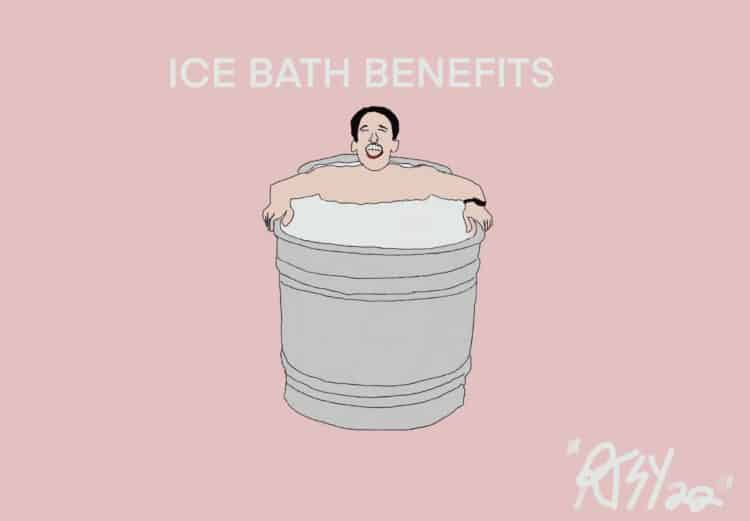If you watch, listen to, or follow Joe Rogan at all, you’ve most likely heard about the Joe Rogan ice bath benefits already.
The podcaster extraordinaire waxes poetic about the Ice bath benefits … frequently! In fact, it’s one of his best-loved health hacks — alongside saunas, regular vigorous exercise, elk meat, marijuana, and a range of vitamin supplements.
Other celebs and elites are also known for their participation in cold plunges. Chris Hemsworth, Lady Gaga, and Miranda Kerr are all known to use cold water therapy as a way to get and stay healthy and attractive.
But what exactly are the benefits of ice baths? Below, we’ll explore why cold water immersion has come to be known as such a beneficial form of therapy — plus, how you can start ice bathing at home and achieve these same amazing benefits.
Table of Contents
What Is an Ice Bath?
An ice bath is basically a bath or small pool that contains cold water and sometimes ice. No matter the type of vessel, it is the extremely low temperature of the water that facilitates “extreme cold immersion” for anyone who has the guts to hop in.
Typical ice bath temperatures are below 50°F and often closer to 35 – 40°F. The more general “cold immersion therapy” is when the water is slightly warmer — usually between 50°F and 60°F. Beginners should also start in this range.

Ice Bath Benefits
People aren’t voluntarily plunging themselves into freezing cold water for nothing! There are numerous Ice bath benefits associated with ice bathing.
Improved Muscle Recovery (Especially After a Workout)
Ice bathing has been used for many years to improve muscle recovery after a workout. When the body is sore and tired, an ice bath immersion can rejuvenate the muscles and provide soreness relief. It also helps your muscles recover more quickly.
Reduced Inflammation
As a general rule, inflammation in the body is associated with a range of health conditions and diseases. Reducing overall inflammation is a way to lessen your propensity for disease and increase the power of your immune system. Many holistic therapies and general health recommendations have the underlying goal of calming inflammation.
The theory surrounding the reduction of inflammation as it is associated with ice bathing involves the fact that when your blood vessels become restricted (by the extremely cold water), swelling and inflammation instantly goes away. These effects fortunately linger and can help you develop a stronger resilience to disease.
Improvement of Future Workouts
Experts state that an ice bath will improve explosiveness and vitality in future workouts. This could be because it allows athletes to recover faster between workouts and because the chilling effects of the ice water soothe and rejuvenate muscles.
Better Sleep
An ice bath is said to cause a big spike in the production of melatonin — a hormone that prompts your body to shut down and get ready for sleep. An increase in melatonin at nighttime has been associated with faster, deeper, and longer sleep.
Better sleep, overall, is associated with a vast number of health benefits, including better concentration and focus, improved mood, a better-functioning immune system, and a longer lifespan overall.
Mental Resilience
As noted many times by Joe Rogan, ice bathing also promotes mental resilience. The act of ice bathing is not easy. It’s difficult to voluntarily plunge oneself into freezing cold water. And to stay there for several minutes is even more difficult.
However, these challenging situations — when repeated regularly — can actually train a person’s stress response and make them more resilient when stressful situations occur at other times in their lives.
How to Ice Bath at Home
If you’d like to try ice bathing at home, there’s no need to go out and buy a Joe Rogan ice bath (Joe has two baths — one at his home and one in his studio). Instead, you can simply use your own bath tub for ice baths.
To ice bath at home, simply fill your bathtub with cold water. Experts recommend adding between one and three bags of ice. If you’re a beginner, you may want to start with just one bag. Alternatively, you can simply start with cold water only. As you continue this practice, you can progressively add more ice.
Beginners should aim to start at a temperature that’s on the “warmer” side for an ice bath — anywhere between 50° and 59°F should suffice. Again, as you continue taking regular ice baths, you can progressively cool down the temperature in your bath with more ice.
How long to ice bath
So, how long should you stay in an ice bath?
For those just starting out with ice bathing, it is not recommended that you stay in the bath longer than 15 minutes. Most first-timers won’t be able to last this long anyway. In fact, most people will want to get out after just a few minutes, and that’s okay. Over time, you can increase how long you ice bath.
So you can know exactly how long to ice bath each time, be sure to have your phone or a timer handy. You should also have a friend or family member standing by as ice bathing can often make your extremities so cold that they grow numb, and getting out of the bath safely may be difficult.
FAQ: Ice Bath Benefits
Can I use my bathtub for an ice bath?
Yes, absolutely. Although an ice bath tub can be useful, you certainly don’t have to have a special Joe Rogan ice bath to try cold plunges. Just be sure to follow proper protocols as at-home ice baths can be more difficult when it comes to regulating temperature.
Can ice baths be dangerous?
It’s critical that ice bathers avoid staying in cold water too long. Lowering your core body temperature too extremely for too long can cause hypothermia. Likewise, using too much ice in your ice bath could result in frostbite — a very real and serious threat.
The key with ice bathing is to follow the protocol of experts and to go slow. You should also have someone you trust nearby to supervise you while you take an ice bath — especially when you’re just getting started.
Who should not use an ice bath?
Ice baths aren’t good for everyone, including those with type I or type II diabetes. Those with high blood pressure or cardiovascular conditions should also probably avoid ice baths. The drastic changes in temperature can constrict the blood class vessels and alter the flow of your blood, which can be dangerous for some people.

